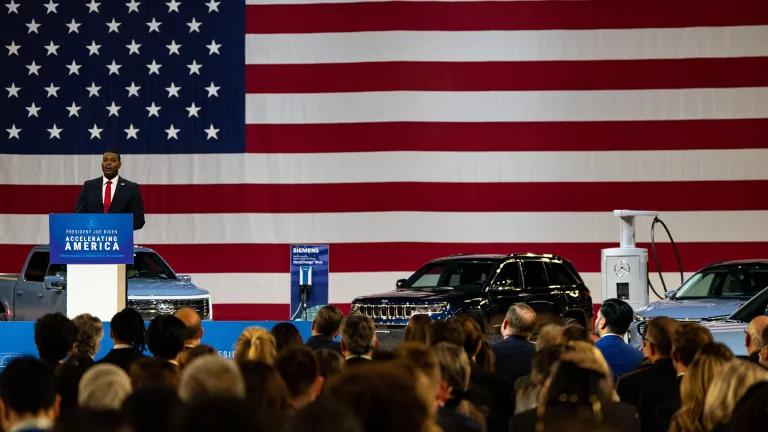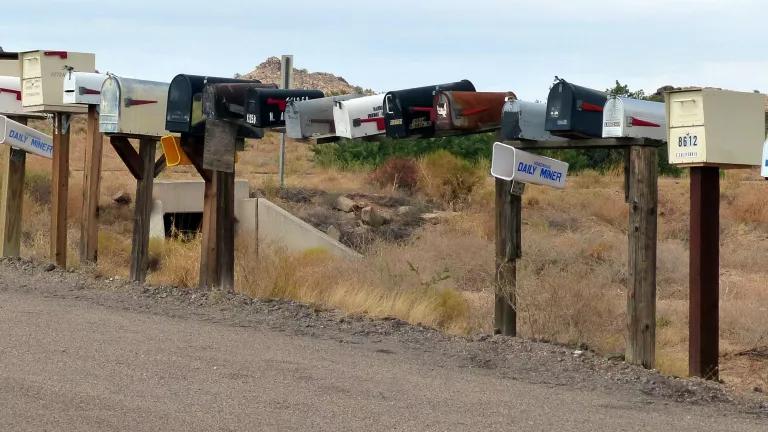EPA Enters the Clean Car Era
The U.S. Environmental Protection Agency's latest clean car rules will provide over $2 trillion in air quality, health, climate, and economic benefits.

Michael Regan, EPA administrator, speaks during an event announcing the Biden administration's moves to reduce pollution from cars and light trucks, March 20, 2024.
Kent Nishimura/Bloomberg via Getty Images
In a big step to confront the climate crisis, the U.S. Environmental Protection Agency (EPA) released new rules to clean up the tailpipe pollution for passenger cars, SUVs, and pickup trucks on our roads, not only enhancing air quality and public health but also delivering significant economic benefits and helping to ensure widespread access to clean cars.
For decades, EPA has been setting tailpipe emission standards that have steadily reduced pollution from the cars and pickup trucks on our roads. These new standards continue this trajectory and help put the United States’ back in the driver’s seat in terms of innovation and environmental leadership in the sector.
The new regulations, slated to affect all new passenger vehicles starting in the 2027 model year, promise significant benefits for the nation. EPA estimates that by 2055, carbon pollution will be cumulatively reduced by over 7 billion metric tons—more than the total greenhouse gas emissions of the entire U.S. in one year.
These rules will provide $2.1 trillion dollars of net societal benefits, with $247 billion in direct driver benefits and $240 billion stemming from health benefits from 2027-2055.
These health benefits stem in part from reducing particulate matter by 95% from gasoline engines. And furthermore, the rules are projected to reduce up to 2,500 premature deaths in 2055.
These regulations help position the United States to keep pace with clean cars policies and technologies being implemented across the globe. For example, the new EPA standards will likely result in automakers including gasoline particulate filters in gasoline engines, a technology that is already used widely in Europe and China. The transition to cleaner cars will also decrease oil consumption by 15 billion barrels through 2055, lessening our reliance on foreign oil.

NRDC's Luke Tonachel, Jada Larson, and Sarah Street pose together at EPA's event
NRDC
EPA’s standards are technology neutral and focused on reducing emissions from the tailpipes of cars and pickups. Automakers can meet the requirements through various technologies, including conventional gasoline hybrids, plug-in hybrid electric vehicles, fully electric vehicles, and cleaner gasoline vehicles. EPA has modelled several potential pathways to understand how automakers may meet the annual requirements.
In one pathway the agency modelled, automakers choosing to focus on an electrification pathway may choose to increase their share of battery electric vehicles and plug-in hybrid vehicles by 2032. EPA notes that automakers may chose this pathway due to the rapidly declining costs of producing EVs, the significant domestic and global investments from automakers in EV manufacturing and increasing demand, and billions of dollars from federal investments, such as the Inflation Reduction Act (IRA) and Infrastructure Investment and Jobs Act (IIJA), which are helping to further decrease the upfront costs of EVs, expanding widespread access to charging infrastructure, and incentivizing new investments battery manufacturing and the EV supply chain here in the United States.
Under this scenario, EPA projects that by 2032 automakers will increase the share of new battery electric vehicles and plug-in hybrid vehicles (which have both a rechargeable battery and gasoline engine) to about 69% of the new sales market.
These EPA rules not only safeguard public health but also deliver cost savings for drivers in terms of fuel and maintenance. EPA estimates that drivers will save up to $6,000 over the life of the vehicle.
While the new clean car rules mark a significant step forward, it is also vital that EPA promptly release strong standards aimed at reducing tailpipe emissions from heavy-duty trucks, which represent some of the most polluting vehicles on our roads.
EPA’s new clean car rules are driving us on a path towards a clean transportation future, and bringing along tons of benefits that all Americans can look forward to experiencing firsthand.



